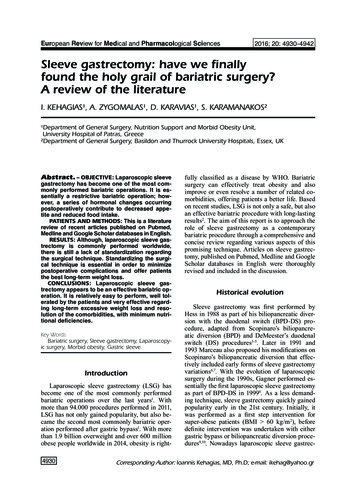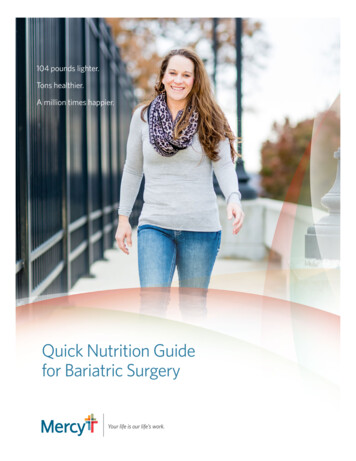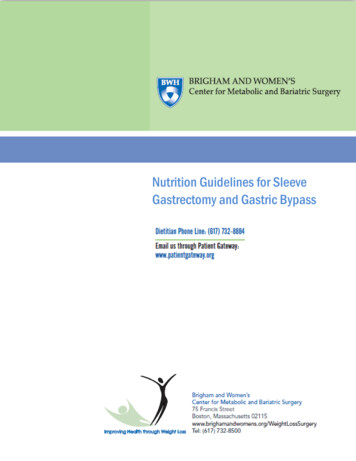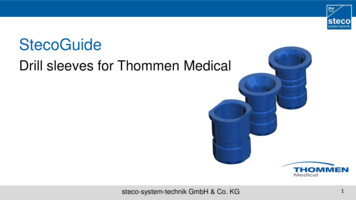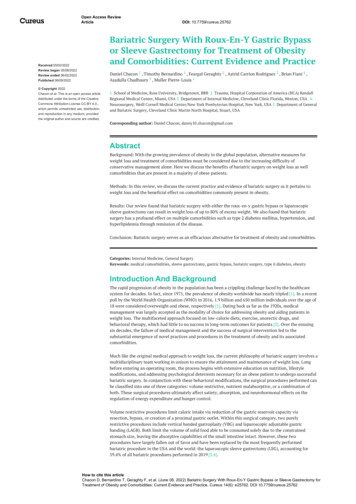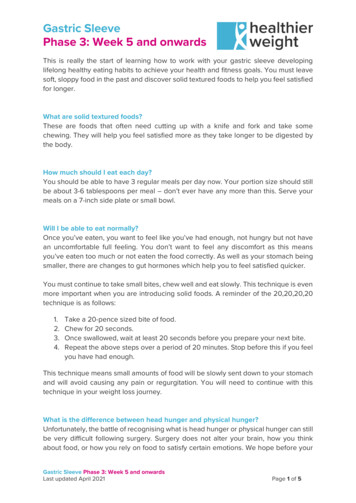
Transcription
Information for patientsSleeve gastrectomy operationWeight-loss surgery3Department of Surgery
IntroductionThe sleeve gastrectomy operation is a very effective procedure tohelp overweight patients achieve a substantial and long termweight loss. It works by restricting your portion sizes and thetypes of food that you can eat.The sleeve gastrectomy can sometimes be used as a twostaged process. This could be the case if the anaestheticrisk of surgery is too great to begin with, and furtherweight loss is required. Some patients will go onto havefurther weight loss surgery such as a gastric bypass.In order to understand your operation, it may help to have someknowledge of the digestive system.Understanding digestionFood is taken in through the mouth and passes through thefood pipe (oesophagus) into the stomach, where it is eventuallybroken down into a semi-solid form. After several hours foodcontinues into the small bowel, which is a long, coiled tube-likeorgan where further digestion and absorption of nutrients takesplace. What remains then continues into the large bowel andeventually will be passed from the body as faeces.Normal stomach
MouthGullet (Oesophagus)StomachLiverDuodenumPancreasSmall bowel(ileum)Large bowel(colon)Back passageopening (anus)The normal bowel (Digestive System)Back passage(rectum)
What is the sleeve gastrectomy?The sleeve gastrectomy reduces the stomach by approximately75% into a banana shape. It is done by stapling down thestomach and removing the remainder of the stomach. The newstomach will hold up to 200ml of fluid at any one time.This means that the amount of food you will be able to eat willbe much smaller and you will feel full quicker. The smallerstomach still works in the same way.To maximise your weight loss it is important that you make lifelong dietary and lifestyle changes. There is no point consideringthis procedure unless you are fully committed to following thedietary and lifestyle advice provided.Stomach following sleeve gastrectomyWhat diet will I have to follow once I have hadthe operation?After the operation the dietitian will give you a diet sheet andexplain to you the dietary changes you will need to make.Remember that the portions will be much smaller and food willhave to be pureed in the early stages after your operation.
You will not be able to take food and fluids together as this willoverfill your new stomach and make you feel sick. You will needto wait 30 minutes before or after a meal to drink fluids.In addition to the smaller portion size, you won't be able totolerate foods which have a high fat content. Fat can be difficultto digest after a sleeve gastrectomy. It can delay stomachemptying and lead to heartburn.High fat foods to avoid are: Fatty meats and meatproducts such as sausages,pate, corned beef, baconand burgers. Mayonnaise Salad dressings Whole milk Condensed milk Evaporated milk Cream Butter/margarine/lard/dripping/oil. Full fat cheese Full fat yogurts Biscuits Cake Crisps Nuts Pastries.What are the benefits of having the sleevegastrectomy?This operation helps you to achieve effective, long-termweight loss.It also reduces health related problems: Type 2 Diabetes Osteoarthritis Hypertension (high blood pressure) Coronary heart disease High cholesterol level
What are the risks, consequences and alternativesassociated with having a sleeve gastrectomy?Most people get through their operation with few problems,however in some cases there may be difficulties.As with any operation, there is a risk of serious complicationssuch as heart attack or blood clot. Extremely rarely, there is a riskof not surviving, due to problems related to the operation.Specific risks associated with the sleeve gastrectomy are; Staple line leak Wound site hernia. Wound infection.This procedure is less associated with developing nutritionaldeficiencies than the gastric bypass operation. These risks aresmall but it is important that you are aware of them and that youhave all the information you need before agreeing to have theoperation.The sleeve gastrectomy is a restrictive procedure. There are othertypes of operation available, which work in a slightly differentway, also detailed in this booklet.There is always the option of not receiving any treatment at all.The consequences of not receiving any treatment are; further weight gain shortened lifespan increase in obesity related diseases (as listed in the benefitsabove) low self-esteem and depression.If you would like more information please speak to yourconsultant or the nurse/dietitian looking after you.
If you would like more information on counselling or weightmanagement programmes, please speak to your GP.What happens before I come into hospital?You will be sent an appointment to attend a group informationsession run by the specialist nurse and dietitian. This is a chancefor you to receive lots of information about the operation.This includes your stay in hospital, lifestyle changes and whathappens afterwards. The dietitian will also give you informationabout what you should and shouldn't eat after your operation.This session is also a good opportunity to meet other people whoare considering weight loss surgery. If you decide that you wishto be considered for surgery, you will be sent an appointment tosee the surgeon for medical assessment. You will also be given asleep study questionnaire to fill in, so that the anaesthetist canassess your risk for the surgery.Pre-operative Assessment AppointmentYou will be asked to attend the hospital for a pre-operativeassessment. At this appointment we will ask you about yourmedical history, medication and any operations you may have hadin the past. You may need to undergo some routine tests eg,heart trace (ECG), X-ray, blood test. You will also be weighed.10 Day Milk and Yogurt DietTen days before your operation date, you will be advised tofollow a milk and yogurt diet. This will shrink your liver, whichbecomes fatty and enlarged in people who are overweight.It is therefore very important that this diet is strictly followed.A smaller liver will make it easier for the surgeon to access yourstomach at operation and reduce your anaesthetic risk.You may also lose weight during this period. If you do not followthis diet there is an increased chance of your surgery not beingable to be undertaken.
It is very important that you are as healthy as possible before theoperation and that you do your best to lose weight. You shouldnot gain weight as this could prevent you from having thesurgery.You will have had an opportunity to discuss the operation withthe doctors in clinic and with the specialist dietitian and specialistnurse at the group session, and hopefully any concerns you mayhave will have been explained.Stop SmokingWe advise you to stop smoking before your operation.Smoking increases your anaesthetic risk.What happens on admission to hospital?The ward is separated into bays with 4 beds in each bay.Both male and female patients are admitted to this ward, thoughthere will only be patients of the same sex in individual bays.The doctors and nurses will answer any questions that you mayhave. Once you have been given all the appropriate information,you will be asked to sign a consent form, which gives writtenpermission to do the operation.A nurse will check your temperature, pulse and blood pressure.The nurse will also check that nothing has changed with yourhealth since you were at pre assessment clinic. You will be askedto put on a disposable gown and pants. You will also be givensome white/black stockings to wear. These promote blood flowthrough the deep veins in your legs, and therefore reduce yourrisk of developing a blood clot. You will be asked to wear thesefor six weeks following your operation.Other health professionals may need to see you at some timebefore the operation, including the anaesthetist, pharmacist andphysiotherapist.
You may be asked if medical students can be involved with yourcare, you do not have to agree to this. If you use a CPAPmachine at night, please bring it into hospital with you.How is the operation done?In most cases the surgery is performed laparoscopically (keyhole),which means that the procedure is undertaken through 5-6 verysmall cuts instead of one large cut. Sometimes this is not possiblefor various reasons and the procedure may have to beundertaken through one large cut (open procedure).If this happens you may have more discomfort after theoperation. You will need to stay in hospital longer and it will be alonger period of time before you can return to normal activities.What sort of anaesthetic will I have?Your operation will be carried out under general anaesthetic,which means you will be asleep throughout. The anaesthetist willvisit you before your operation and discuss the anaesthetic withyou.What happens immediately after the operation?After the operation you may be on the High Dependency Unit(HDU). This is a unit which provides more intensive nursing.Patients with sleep apnoea and/or respiratory complications oftengo to the High Dependency Unit.You will have your pulse, blood pressure, breathing and woundschecked regularly by a nurse. It is usual to feel sleepy for severalhours. You will be given oxygen through a face mask until youare more awake. Anaesthetics can sometimes make people feelsick. It is important to tell the nurse immediately if you feel sick.They may offer you an injection which will help to settle it.
You will have a catheter in your bladder to monitor your urineoutput. You will have a drip or 'intravenous tube' in yourarm/hand, which will give you fluid until you are well enough todrink an adequate amount. For the first 2 days following youroperation you will only be allowed sips of fluid. The doctors willadvise you when it is safe to increase your fluid intake, and whenyou are able to tolerate more fluid, the drip will be removed.If no problems are experienced you will then move on to the nextstage. You will be given an information book and advice fromthe dietitian about how to increase your intake gradually.You will then have a pureed diet which you can choose from aspecial menu sheet, designed for patients who have had weightloss surgery. This allows any internal swelling to reduce and helpsyour new stomach to heal more quickly.Following your operation, the dietitian will help you adjust toyour new diet particularly in the first few months. You will begiven a detailed diet and information sheet to help with this andyour diet and weight will be checked regularly, to make sure it isadequate.Will I have stitches?Wounds are usually stapled together with metal clips to keepthem together while they heal. Clips will be removed after10 days. You will have dressings/large plasters covering yourwounds.Will I be in pain?Most patients having this operation experience some pain.If you have pain, it is important to tell the nurses, who will giveyou drugs to help. You may have a patient controlled analgesiadevice (PCA), where you press a button and a machine gives youa small dose of a painkilling drug. This will be explained to youbefore your operation and is very safe and easy to use.
Or, you may have a small tube in your back, which can be usedto give you painkilling drugs.How soon can I get out of bed after myoperation?You will be encouraged by the nursing staff andphysiotherapists to get up and about as soon as possible afteryour operation. This is important to reduce the risk of bloodclots, and also to prevent problems with your chest.When will I be able to go home?You will be able to go home 3-5 days after your operation.Everyone is different and some people may need to stay inhospital longer than others.How will I feel when I get home?You are likely to feel tired and need to rest during part of theday but this should improve with time.What should I look out for?Check your wounds for signs of infection - redness, pain andheat. If any of these occur, see your GP as you may need acourse of antibiotics.Your abdominal area is likely to feel bloated and sore for a fewweeks. This is normal. Take either the painkillers you were givenfrom the hospital or a mild painkiller such as paracetamol (follow the manufacturers instructions and do not exceed thestated dose).When will my stitches be removed?These will be removed at 10 days by your district/practice nurse.
How long will I need to be off work?You will need to take about 3-6 weeks off work depending onthe kind of job you do.When can I return to normal activities?We would normally expect you to take about 3-4 weeks to getback to normal activities. You should avoid heavy lifting for 2-4weeks.Can I drive my car?Do not drive until you can wear your seat belt comfortably andfeel able to perform an emergency stop. Your insurancecompany may refuse to meet a claim if they feel you have driventoo soon.When can I start to do some exercise?As you start to feel better, it is important to introduce gentleexercise such as walking. As you start to lose weight you willfind that you feel more energetic and are able to undertakemore vigorous exercise. This will also help you to lose weightand to tone muscles.Will I need any different medication?You will be sent home with a 10 day supply of a blood thinningdrug called clexane, which will need to be given through a smallinjection into the skin on your abdomen.Initially some tablets are going to be too large for your newstomach. Your GP may already have changed these tochewable, dissolvable or syrup form. If not, the ward pharmacistwill do this. In some instances the medication doses may changeor you may be advised to stop taking some of your medication.
If you are on medication for diabetes, you may need to haveregular checks with your GP or practice nurse in order tomonitor your blood sugars and medication.Vitamin and Mineral SupplementsYou will need to take a daily vitamin and mineral supplementfor the rest of your life. Initially chewable or dissolvable vitaminand mineral supplements will be required to ensure that theycan pass through the new stomach. There is currently nochewable or dissolvable vitamin/mineral supplement available onprescription. You will also need to have vitamin B12 injectionsevery 3 months, lifelong.Will I have to come back to hospital?Yes, an outpatient appointment will be made for you four to sixweeks after you go home in order that the team can check onyour recovery.You will also be seen by the dietitian in clinic in order that yourweight, diet and nutritional status can be carefully monitored.You will then be reviewed by the dietitian/specialist nurse at3 months, 6 months, 12 months and 2 years.After 2 years you will be discharged back to your GP for routineannual follow-up.How will this affect my life?As you start to lose weight, you will feel much healthier. It isimportant to remember that these changes will affect your lifein terms of eating out, going for a drink with friends, going onholiday and buying new clothes. The support of family andfriends is very important, particularly if you have to prepare largemeals for other family members.
Some patients have reported taste changes after the surgery andother patients have reported some hair loss. It is important thatyou are aware of the long term changes that will affect yourlifestyle and your relationships with others.Is there any additional support?There is a weight management support group meeting, whichtakes place once a month and is open to all patients who havehad this surgery and those who are waiting for surgery. It is afriendly informal meeting when patients can get together todiscuss their experiences with other patients as well as with theappropriate health care professionals. The times and dates ofthese group meetings are available in the outpatient clinic orfrom the specialist dietitian/nurse specialist.How much weight will I lose?It is difficult to predict how much weight you will lose, aseverybody is different and weight loss will still be dependent onyour food choices and exercise. Weight loss with a sleevegastrectomy is expected to be between 30 and 50% of yourexcess body weight at 12-18 months. You will still have tofollow a low calorie healthy eating diet, and exercise to achievea successful long term weight loss.What will happen to the loose skin I will beleft with?Many patients who have lost a great deal of weight may haveloose skin, particularly at the tops of their arms and legs andaround the stomach. Referral to a plastic surgeon to remove theskin from these areas can be arranged through your GP if youmeet the referral criteria. It is important to remember that thiswill only happen when enough weight loss has been achievedand is being maintained.
Will this operation affect any future pregnancies?We do not advise you to consider becoming pregnant until atleast 12 months after your operation. This will allow your bodytime to adjust to its new condition and for you to be fullyestablished on a varied, healthy diet.If you are planning to become pregnant it is important that thedoctors, dietitian and midwives looking after you are aware thatyou have had weight reducing surgery. They will be able tomonitor both you and the baby accordingly. It is important thatyour diet is nutritionally balanced, which will keep both you andyour baby healthy.Who will be looking after me?Consultant Surgeon:Mr Roger AckroydConsultant Surgeon:Mr Kirt PatelSpecialist Dietitian:Mrs Nerissa WalkerSpecialist Nurse:Miss Liz GovanConsultant Radiologist:Dr Fred Lee & Dr Robert PeckRadiographer:Chris PridmoreAnaesthetists:Dr Paul Murray & Dr Nick Barron
Useful ContactsDella Oldham (Secretary to Mr Ackroyd and Mr Patel)Tel: 0114 305 2411Liz Govan (Nurse Specialist)Tel: 0114 226 9083Nerissa Walker (Specialist Dietitian)Tel: 0114 226 9083Northern General HospitalTel: 0114 2434343NHS DirectNHS Direct is a 24 hour nurse-led, Tel: 0845 4647 or visit theconfidential service providingweb site at:general health care advicewww.nhsdirect.nhs.ukand information.Useful websites for further information:www.bospa.org (British Obesity Surgery Patients Association)www.wlsinfo.org.uk (Weight Loss Surgery Information andSupport)www.british-obesity-surgery.org(British Obesity and Metabolic Surgery Society)Sheffield TeachingHospitals supportsorgan donation.Do you?This information can be made available on request in alternativeformats including Braille, large print, audio, electronically and otherlanguages. For further details email: alternativeformats@sth.nhs.uk Sheffield Teaching Hospitals NHS Foundation Trust 2010.Re-use of all or any part of this document is governed by copyright and the “Re-use of Public SectorInformation Regulations 2005” SI 2005 No.1515. Information on re-use can be obtained from the InformationGovernance Department, Sheffield Teaching Hospitals. Email infogov@sth.nhs.ukPD5173-PIL1697 v2Issue date: January 2011. Review date: January 2013
The sleeve gastrectomy can sometimes be used as a two staged process. This could be the case if the anaesthetic risk of surgery is too great to begin with, and further weight loss is required. Some patients will go onto have further weight loss surgery such as a gastric bypass. In order to understand your operation, it may help to have some
